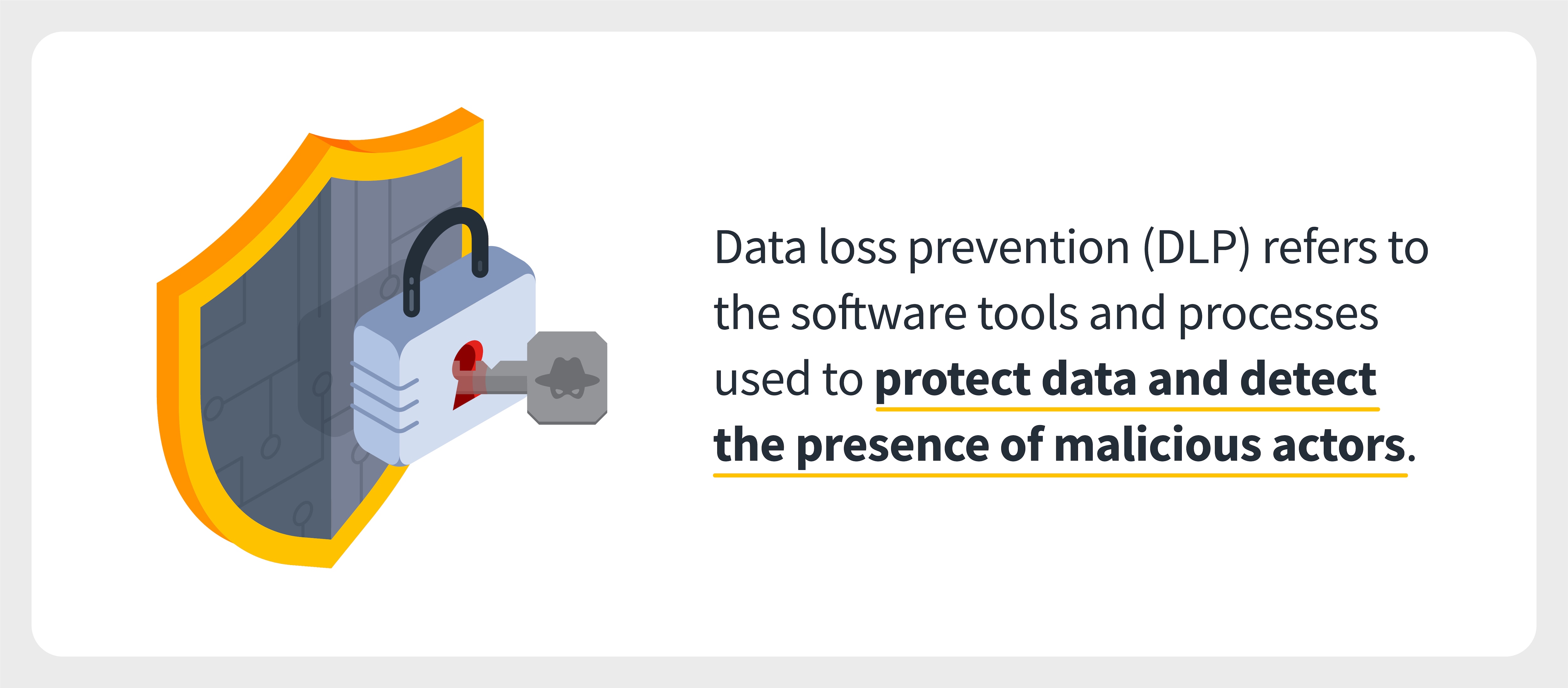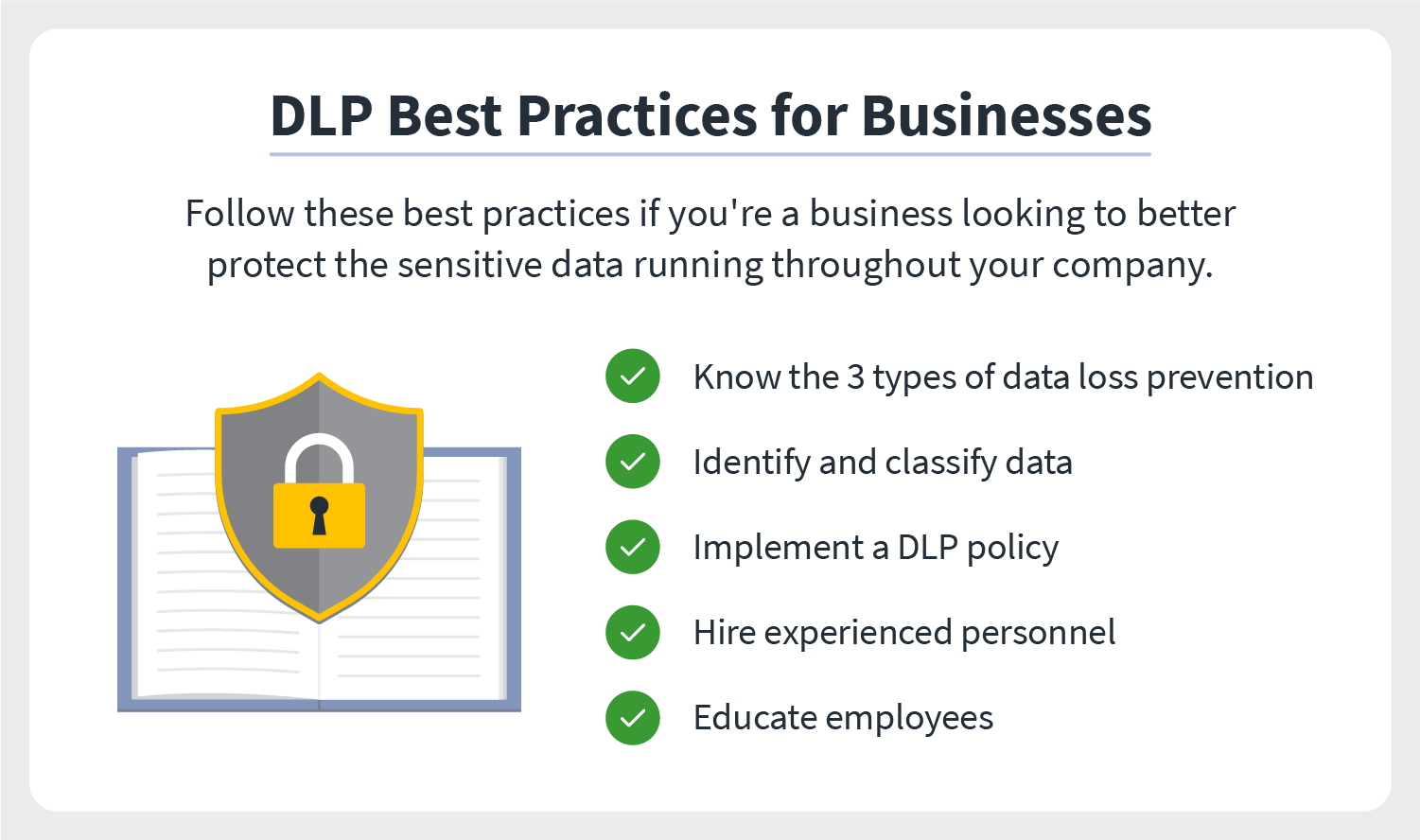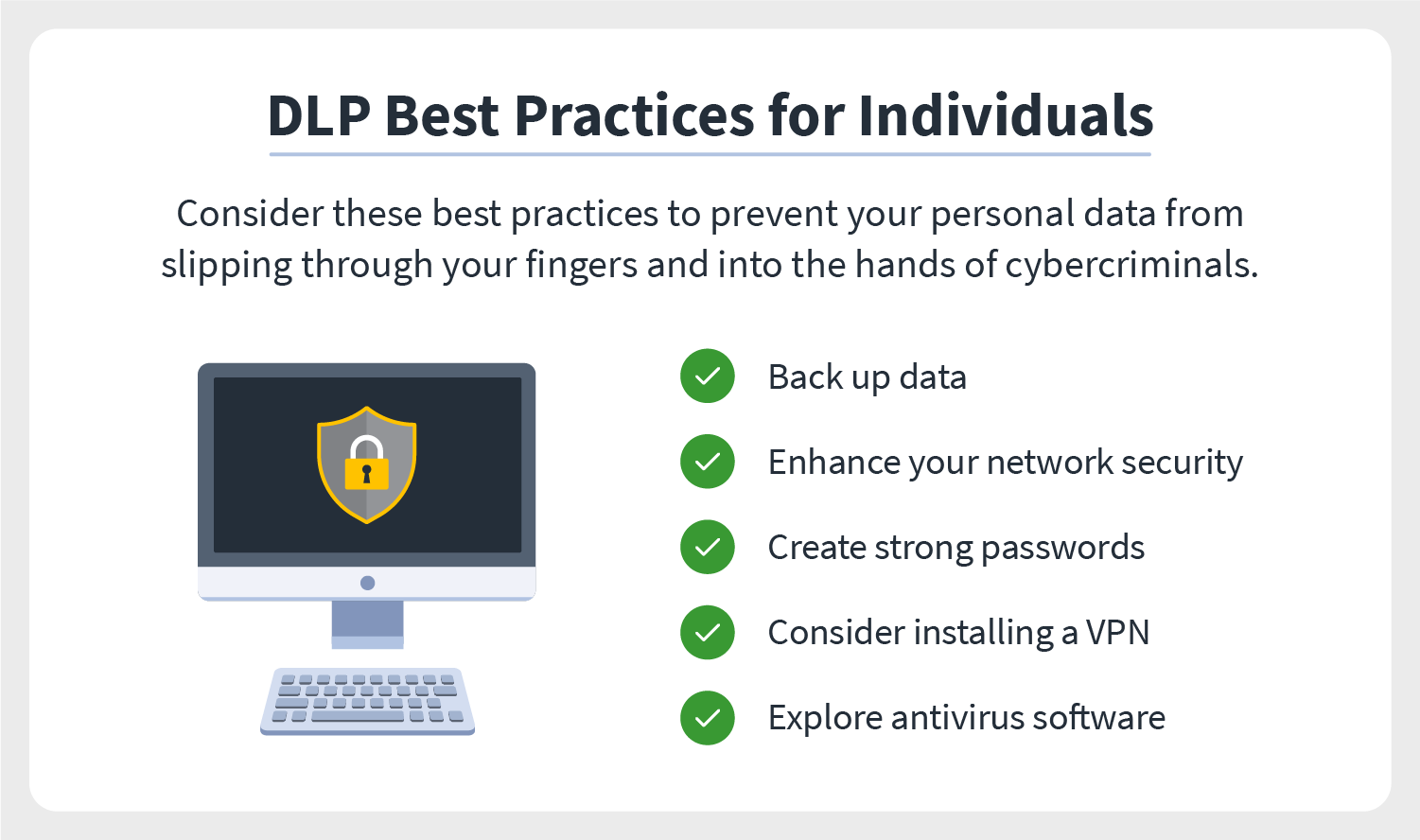Data loss prevention: What is DLP + how does it work?
What are data loss prevention tools you can use to protect your network? Read further to educate yourself on some DLP best practices and level up your cybersecurity as a whole.

Data loss prevention (DLP) refers to the software tools and processes used to protect sensitive data and detect the presence of malicious actors looking to get their hands on your data. In other words, data loss prevention is just what it sounds like — preventative measures to ensure your data isn't lost. And considering the number of annual cyberattacks could double by 2025, DLP is something that should be top of all online users' minds.
Here’s an overview of all you need to know about DLP, from answering “What is DLP?” and explaining how DLP works to providing best practices people can use at home and in the office. Read on to learn how to keep your data from slipping through the cracks.
What is data loss prevention?

The answer to “What is data loss prevention?” is relatively simple. Data loss prevention refers to the cybersecurity practices and precautions that people and businesses use to avoid and detect the loss of data on their network, be it the result of data breaches, malware attacks, or other methods. While everyday online users should be interested in DLP to protect their personal data and devices from these incidents, businesses are invested in DLP to secure their data in a way that complies with government regulations.
Data loss prevention is often confused with data leakage prevention, which is similar but it does have a significant distinction. Data leakage prevention refers to the ways in which businesses prevent data security breaches. Data leakages occur when sensitive information flows out of the organization and into the hands of an unauthorized user. Data loss, on the other hand, takes place when data is accidentally lost or stolen by a cybercriminal. Common solutions for a data leakage within a company include creating safeguards like DLP policies and privacy laws for online users.
How does DLP work?
Individuals and organizations can break DLP down into two actions:
- Identifying sensitive data that needs protection
- Using data loss prevention tools and softwares that will prevent data breaches, malware attacks, or other types of hacking methods
For individuals at home, this may involve:
- Creating a guest network for vulnerable IoT devices
- Downloading antivirus software
- Installing password managers
Businesses may consider:
- Implementing data loss prevention software
- Enforcing password protocols for customers and employees
- Monitoring access to sensitive documents and information
Why is DLP important?
Unfortunately, our digital world is full of hackers trying to gain access to information that isn’t theirs. And cybercriminals are becoming smarter and smarter, as 450,000 new types of malware appear every day on the internet, endangering the data of individuals and businesses alike. Taking the time to understand DLP could potentially keep you from falling victim to some of this malicious software and losing your data.
Here are some additional reasons why people and businesses should be concerned with preventing their data from being lost.
Individuals:
- Data protection: Keeping your private data out of the hands of cybercriminals can prevent crimes, such as identity theft, from taking place.
- Network security: DLP goes hand in hand with network security. Incorporating a DLP plan can help protect your main network and the devices connected to it.
- IoT device security: IoT devices are much safer when they are under the protection of things like antivirus software and guest networks that help keep your data hidden.
Businesses:
- Compliance: Though regulations can vary based on country, state, or industry, most businesses must comply with mandatory data protection standards imposed by governments. These standards regulate how companies organize and protect their customers’ data.
- Intellectual property: A company network vulnerable to hackers could risk their trade secrets and business strategies being released to the public for everyone to see.
- Data transparency: In order for a company to protect its data, it has to know where data is stored, who has access, and for what purpose. This can help identify weak points and eliminate unnecessary risks.
Common causes of data loss
There are several ways in which a business or person could lose sensitive information. Here are some common causes of data being misplaced or hijacked, as well as tips to avoid them.
Malware and viruses
Malware and other internet viruses are among the leading causes of data loss on personal and corporate computers. These attacks often begin with phishing emails embedded with malicious links that infect your computer after opening.
- DLP tip: Install antivirus software on your computer and monitor your email inbox for spam messages.
Accidental data exposure
Data breaches can occur as a result of people accessing their information over unsafe networks. For businesses, employees might make the mistake of opening work information on public Wi-Fi. With no firewall or VPN protection, that potentially sensitive information is free for the taking.
Everyday online users can also make the mistake of using public internet to open their email or access banking information, which is equally as dangerous.
- DLP tip: Avoid connecting to public networks, verify a website is secure before inputting personal identifiable information, and consider using a VPN to encrypt the data you send and receive.
Software malfunctions
These are sometimes out of the control of the user, but unexpected software malfunctions, such as shutdowns, can result in the loss of data. This occurs when your system randomly quits and closes its applications without warning, oftentimes resulting in a reboot. Without getting the chance to save work in progress, there is no guarantee that your information will be there when the device starts back up.
- DLP tip: Remember to always save your work as you go and be sure to follow instructed logout and shutdown procedures.
Insider threats and hackers
Insider threats and hackers use compromised credentials to gain access to user accounts to steal information either from a person or company. This could result in something as serious as identity theft or the data exposure of countless customers.
- DLP tip: Create a DLP policy to better protect and manage data and privacy.
5 DLP best practices for businesses

Businesses should prioritize the protection of their data, as it is essential to daily operations. Below you will find DLP best practices that can help companies create a safe environment to house their data.
1. Know the 3 types of data loss prevention
Before deciding what types of DLP procedures would work best for your business, it might help to have an understanding of what the types of data loss prevention for businesses are. Generally, there are three types of data loss prevention software for businesses.
- Network DLP: This is a type of DLP software that puts a shield over your business’s network and tracks moving data in the system. Should an employee try to send information outside the network, the system can either report, encrypt, or block the message based on preset settings.
- Endpoint DLP: Endpoint DLP software adds protection to each device connected to the business’s network. It provides more specific protection to the devices employees are using on a daily basis.
- Cloud DLP: Cloud DLP software protects business networks by enforcing the rules of a DLP policy the company creates on cloud accounts like Google Workspace or Office 365. This allows employees to use cloud-based apps without the fear of data loss or breaches.
2. Identify and classify data
All the data running throughout your organization isn’t the same. In order for you to protect your data, you need to know what kind of data you have. Businesses should identify the data used for operations, such as financial records, customer information, and phone logs. They’ll then need to categorize this data based on the level of importance to prioritize what’s most sensitive and needs added protection.
3. Implement a DLP policy
DLP policies outline how a company can protect and share its data. They include rules and procedures that a business implements throughout its entire network. Examples may include prohibiting the distribution of information outside of the established network or tracking user access to limit who can see what. DLP software can adhere to these rules and procedures to protect your network from internal and external threats that may arise.
4. Hire experienced personnel
In order to have a successful DLP policy, you need to bring in the help of experienced professionals with a background dealing with data breach reporting, DLP risk analysis, and data protection law. Having this well-rounded team build out your DLP strategy will ensure you have a solid plan in place
5. Educate employees about DLP
Data loss prevention is an ongoing process, and employees are critical players in regard to its success in a business. Educating workers on new DLP software, rules, and procedures can help streamline data protection. This will also ensure that everyone is aware of how the company is legally required to handle the data it stores.
5 DLP best practices for individuals

There are several things you can do at home to build a Cyber Safe environment. Think about incorporating these best practices into your daily life to keep your devices, network, and information safe.
1. Back up your data
There’s almost nothing worse than having a computer shutdown that wipes out some important data. But sometimes these things are out of your control. One thing you can do to lessen the chances of your information getting lost is backing up your data. Investing in an external hard drive, cloud storage service, or removable media device can be a lifesaver when you least expect it.
2. Enhance your network security
Taking the time to review the devices connected to your network could potentially help you identify unauthorized users that may be stealing your data. Because some devices are better at signaling suspicious activity than others, there’s a chance a breach could go undetected for months.
Segmenting your network is another option that would aid in your effort to protect your personal data. It involves splitting the bandwidth of your router to create a Wi-Fi network separate from the network you use regularly.
People often create these guest networks to provide a place for less secure IoT devices, such as smart TVs, gaming consoles, and smart speakers, to operate on. Keeping these devices on a separate network can protect your more personal devices from corruption.
3. Create strong passwords
One of the first steps you can take to protect yourself from hackers looking to destroy or steal your data is creating strong and unique passwords for each of your online accounts. By doing this, the chances of attackers using credential stuffing techniques on you are significantly lowered. If you struggle with ideating and saving passwords, consider a password manager that takes care of it for you.
4. Consider installing a VPN
Installing a VPN is one widely used method of encrypting the data you send and receive to fight against cybercriminals at large. It works by hiding your IP address by bouncing it off a server located far away from your location. This adds a kind of anonymity to your online identity, allowing you to browse safely, even on a public network.
5. Explore antivirus software
You can think of antivirus software as the best friend on your shoulder always looking out for your best interests. This protective software can provide suspicious network activity alerts, highlight potentially malicious links, and scan your device for dangerous viruses. You’ll be able to surf the web with ease knowing you're doing everything you can to help protect your data.
Securing your data from the many emerging threats that could lead to its disappearance or theft takes some time and thought. However, by adhering to these DLP best practices, you’ve already put yourself on the right track for success.
Editorial note: Our articles provide educational information for you. Our offerings may not cover or protect against every type of crime, fraud, or threat we write about. Our goal is to increase awareness about Cyber Safety. Please review complete Terms during enrollment or setup. Remember that no one can prevent all identity theft or cybercrime, and that LifeLock does not monitor all transactions at all businesses. The Norton and LifeLock brands are part of Gen Digital Inc.





Want more?
Follow us for all the latest news, tips, and updates.